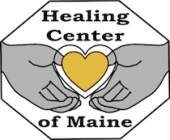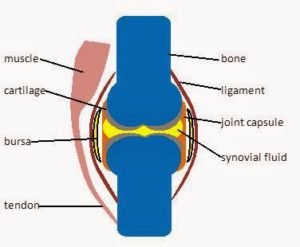Do you suffer from joint pain; rotator cuff, tennis elbow, carpal tunnel, or other joint pain? Rotator cuff and tennis elbow are two joint issues I have personally struggled with. This 3 part series will discuss how you can begin to heal your joint pain. Part 1 will deal with understanding how healthy joints function and what can go wrong. Part 2 will show you how to assess your joint health to determine which joints need intervention to prevent injury. Finally, Part 3 will provide methods for beginning to heal joint pain.
Anatomy of a Joint
Let’s first consider how the joint is constructed. Two separate bones meet to form a mechanical joint. To prevent abrasion, we need some form of lubrication between the adjoining bones. This is requirement is fulfilled by cartilage. Cartilage is a soft tissue which is very resistant to abrasion, is slippery, and can absorb a high level of compression. A thick layer of cartilage covers the ends of each adjoining bone. The joint must also be held together. A “joint capsule” fulfills this requirement. Somewhat like a shrink-tube, the joint-capsule completely encloses the joint. The outer layer of this joint capsule is made from dense, fibrous, connective tissue and is supported by ligaments. Ligaments are soft tissues which attach bone to bone. They are very tough and not very flexible, as fits their primary role of holding the joint together. The inner layer of the joint capsule is composed of a yolk like substance called “synovial fluid”. Its purpose is to reduce friction between the two, cartilage covered bones. Some joints also contain separate sacs filled with synovial fluid called bursae. These bursa function as a cushion between the bones of the joint and tendons and/or muscles around the joint.
Healthy Joints with a Complete Range of Motion
My grandson, who is not yet two years old, is a source of great fascination for me in many ways but particularly in his free range of movement. As I see him effortlessly drop into a flat-footed, and perfectly straight-backed, full squat, I’m reminded of the perfect flexibility and posture we are all born with. So what happens to this mobility we are all born with?
I believe the key to understanding joint health is the combined functional role of the joint elements. They must allow the joint to move within a prescribed range, neither over-extending, nor under-extending in the sense of long periods of limited range of motion. So what we need is to move our joints over their full range of motion on a daily basis. That sound like exercise? Yes, but a little more than that. Exercise that only moved some of the joints, or that didn’t move them over their full-range wouldn’t fit the bill.
How We Damage Our Joints and Limit Our Mobility
If we don’t use our joints at all, then tendons, ligaments, and even synovial fluid, will lose their limited pliability. Our habits, posture, and daily activities, or lack of daily activities can and do physically alter our joint structure. Muscles, tendons, and ligaments adjust their lengths to the perennial demands of their owner. Posture and repetitive motions in less than the full range of motion, shorten and limit the joint’s mobility. Posture and repetitive motions in excess of the natural range of the joints, over-extend mobility and expose the joint to dangerous over-extention. Now suppose we have shortened and weakened some of the structures in our joint and over-stretched other structures. We’ve compromised the structural integrity of the joint. In other words, we’ve severely reduced the ability of the joint to withstand stress. This is just about the time we decide to start a new exercise program, or spend the whole weekend getting in the firewood for winter, or a host of other possibilities. Guess what happens to those joints with the compromised structural integrity? We injure them and they start to cause pain. Then we wonder, “How could that happen, I used to do that all the time when I was younger.”
In Part 2 of this series we’ll discuss how to assess your current joint health to determine which joints need intervention to prevent injury.
I welcome your comments on this post.
I welcome your comments on this post.
Written by Peter Wright
Latest posts by Peter Wright, NTP, CGP (see all)
- Dehydrated Broth – Making It Easy to Drink Broth Every Day! - March 11, 2017
- Lose 10 lbs DURING the Holidays - November 19, 2016
- Finding Good Oils - February 7, 2016



No comments yet.